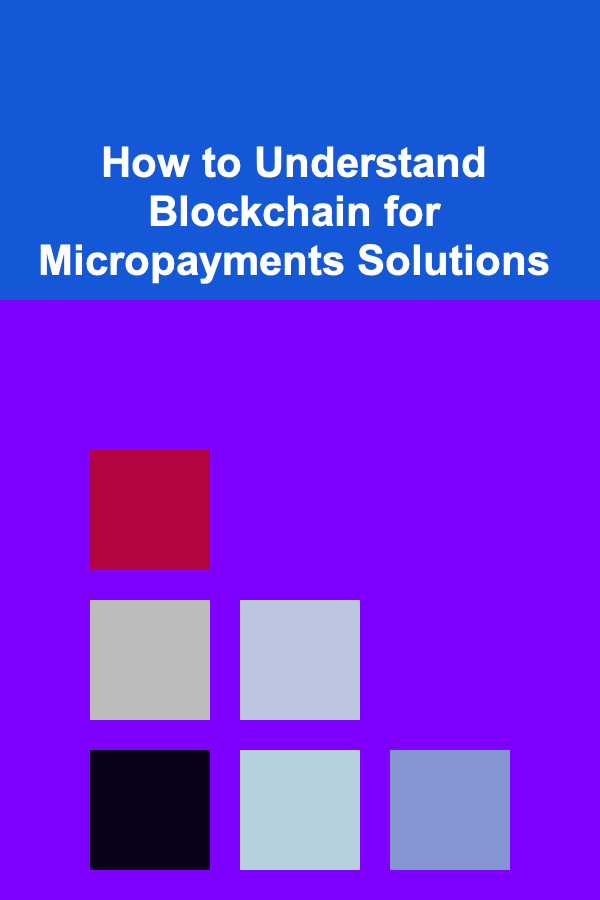
How to Understand Blockchain for Micropayments Solutions
ebook include PDF & Audio bundle (Micro Guide)
$12.99$7.99
Limited Time Offer! Order within the next:

Micropayments, small-scale transactions involving tiny amounts of money, have become increasingly important in today's digital economy. With the rise of online services, content platforms, gaming, and other digital economies, the need for efficient, cost-effective, and secure ways to handle these small transactions has grown. Traditional payment methods often struggle with micropayments due to high transaction fees and inefficiencies. This is where blockchain technology comes in, offering a promising solution.
Blockchain, often associated with cryptocurrencies like Bitcoin and Ethereum, is a decentralized and secure method for recording and verifying transactions. By leveraging the inherent advantages of blockchain---such as low transaction fees, transparency, and security---micropayments can be handled more efficiently than with conventional payment systems. In this article, we'll explore how blockchain can revolutionize micropayments, how it works, and why it's a game-changer for small transactions.
The Problem with Traditional Payment Systems for Micropayments
Before diving into how blockchain works for micropayments, it's essential to understand the challenges presented by traditional payment systems for these small transactions. Traditional systems like credit card networks, bank transfers, and even payment services like PayPal typically charge fixed fees for processing transactions. These fixed fees are often not scalable when dealing with micropayments. Let's break down the issues:
1. High Transaction Fees
Traditional payment systems impose relatively high fixed fees regardless of the amount transacted. For example, a standard credit card transaction might cost around 2.9% + $0.30 per transaction. For a $1 payment, this results in a 30% fee, which is not feasible for microtransactions of a few cents. This makes micropayments impractical using conventional payment methods because the fees quickly exceed the value of the transaction.
2. Slow Transaction Times
Bank transfers, especially international ones, can take a long time to process. While credit cards can process transactions quickly, the backend processes that occur (such as approval, verification, and settlement) can introduce delays. For many micropayment-based services, speed is crucial, as a delay of a few minutes can be detrimental to the user experience.
3. Currency Conversion Fees
Micropayments often involve users across different regions and countries. Currency conversion adds another layer of complexity and cost. Converting between different fiat currencies often comes with an additional fee, further eating into the value of small payments.
4. Limited Accessibility
Not all users have access to traditional banking services, especially in developing regions. The requirement for a credit card or a bank account excludes a significant portion of the global population from engaging in digital micropayments. These limitations create barriers for many potential users.
5. Lack of Transparency
Traditional payment systems involve intermediaries like banks or payment processors that control the flow of money. These intermediaries can introduce inefficiencies and create a lack of transparency. The user has to trust that the system is accurate, and that their funds are handled properly.
What is Blockchain?
Blockchain is a decentralized, distributed ledger that records transactions across many computers in such a way that the registered transactions cannot be altered retroactively. Each block in the blockchain contains a record of multiple transactions and is connected to the previous block, forming a chain. This makes it very difficult to manipulate the information within the blockchain, offering high security and transparency.
Key features of blockchain include:
- Decentralization: Instead of relying on a central authority like a bank or payment processor, blockchain relies on a network of nodes (computers) that work together to verify and record transactions.
- Security: Blockchain uses cryptography to secure data and ensure that transactions are tamper-proof.
- Immutability: Once a transaction is added to the blockchain, it cannot be changed or deleted, making it highly reliable.
- Transparency: Blockchain is transparent by design. All participants in the network have access to the entire transaction history.
How Blockchain Works for Micropayments
Blockchain has the potential to solve many of the issues associated with micropayments, enabling them to become more practical and scalable. Let's take a look at how blockchain technology works for micropayments solutions.
1. Lower Transaction Fees
One of the primary advantages of blockchain technology is the ability to reduce transaction fees. Traditional systems rely on intermediaries like banks and payment processors, all of which charge a fee for their services. In contrast, blockchain eliminates the need for intermediaries. Transactions are verified by a distributed network of nodes, which reduces the associated costs.
Cryptocurrencies, such as Bitcoin and Ethereum, have gained popularity as alternatives to traditional payment systems due to their ability to process transactions at a fraction of the cost of traditional methods. Even though transaction fees on major blockchain networks can sometimes be high, newer blockchain platforms and Layer 2 scaling solutions (discussed later) are making micropayments more feasible.
2. Faster Transactions
Blockchain networks are able to process transactions more quickly than traditional banking systems. While bank transfers can take days, and credit card transactions may take several hours to settle, blockchain transactions can occur in minutes, or even seconds, depending on the platform.
For example, Bitcoin transactions can take anywhere from 10 minutes to an hour, while Ethereum can process transactions in under a minute. These faster transaction speeds make blockchain a viable solution for micropayments, where the timeliness of the transaction is often crucial.
3. Borderless Transactions
Blockchain operates globally, without the need for currency conversion or international transfer fees. This makes it an ideal solution for micropayments across borders. A user in one country can send a micropayment to a user in another country without the burden of exchange rates or high fees that are typically associated with international payments.
This borderless functionality is particularly beneficial for the developing world, where many people don't have access to traditional banking services. Cryptocurrencies can provide financial inclusion by allowing individuals to make micropayments without the need for a bank account.
4. Security and Transparency
Blockchain's inherent security features make it an ideal solution for micropayments, where the risk of fraud or disputes is high. Each transaction is cryptographically secure, and once added to the blockchain, it is immutable. This ensures that micropayments cannot be altered or reversed.
Additionally, blockchain's transparency allows all participants in the network to verify transactions. This is particularly useful for platforms that require an audit trail or for users who want to confirm that their payment has been received and processed correctly.
5. Smart Contracts for Automated Payments
One of the most exciting features of blockchain is the ability to create smart contracts---self-executing contracts with the terms of the agreement directly written into code. In the context of micropayments, smart contracts can be used to automate payment processes. For example, a content platform could use smart contracts to automatically pay content creators based on the number of views their content receives. This reduces the need for intermediaries and ensures that payments are made automatically and fairly.
6. Micropayment Channels and Layer 2 Solutions
Although major blockchain networks like Bitcoin and Ethereum are not optimized for high-frequency micropayments due to transaction fees and congestion, Layer 2 solutions are addressing this issue. Layer 2 refers to secondary frameworks built on top of existing blockchain networks that enable faster, cheaper transactions.
A popular Layer 2 solution for micropayments is the Lightning Network, which operates on top of the Bitcoin blockchain. The Lightning Network allows users to open payment channels between each other, where they can transact off-chain. Only the final balance is recorded on the main blockchain, which significantly reduces transaction costs and improves speed. This makes it possible to conduct millions of microtransactions without incurring high fees.
Other blockchain projects like Raiden Network (for Ethereum) and Celer Network also provide Layer 2 solutions for scaling micropayments.
Real-World Applications of Blockchain for Micropayments
Several sectors and industries are already experimenting with or implementing blockchain-based micropayments solutions. Below are some of the key use cases:
1. Digital Content Platforms
Content platforms, such as news websites, gaming platforms, and streaming services, can benefit greatly from blockchain micropayments. Traditional content platforms rely on advertising and subscription models, but these methods often fail to monetize smaller transactions. Blockchain micropayments allow users to pay tiny amounts for individual pieces of content, such as reading an article or watching a short video. This allows content creators to be compensated fairly without requiring users to commit to a subscription.
2. Online Gaming
The gaming industry has long struggled with small in-game transactions, such as paying for items, skins, or features. Blockchain micropayments can streamline these transactions by allowing players to make instant, low-fee payments. Additionally, the transparency and security of blockchain can reduce the risk of fraud and cheating in online games.
3. Internet of Things (IoT)
The rise of IoT devices has led to the need for a system that can handle small payments between devices. For instance, a car could pay a toll booth, or a smart refrigerator could order groceries automatically when supplies run low. Blockchain can provide a secure and efficient way for these devices to make micropayments, facilitating autonomous transactions without human intervention.
4. Crowdfunding and Donations
Blockchain micropayments are ideal for crowdfunding campaigns or donation platforms, where small contributions from many people add up. Blockchain allows for direct, transparent, and secure donations, which is particularly valuable for nonprofit organizations or creators seeking funding from small donors across the globe.
Challenges and Considerations
Despite the numerous benefits of blockchain for micropayments, several challenges remain:
- Scalability: While Layer 2 solutions help, scalability remains a challenge for many blockchain networks. High transaction volumes can still create congestion and lead to delays.
- User Adoption: The average user may find it difficult to understand or trust cryptocurrencies. More education and user-friendly interfaces are needed to increase adoption.
- Regulatory Uncertainty: Blockchain-based payments are still subject to evolving regulatory environments. Governments may introduce new regulations that could impact micropayment systems.
- Volatility: Cryptocurrencies are often volatile, which may make users hesitant to use them for micropayments, where precision and stability are crucial.
Conclusion
Blockchain technology offers a promising solution for enabling efficient, low-cost, and secure micropayments. By eliminating intermediaries, reducing transaction fees, and providing faster transaction times, blockchain has the potential to revolutionize how we handle small-scale transactions. However, challenges such as scalability, user adoption, and regulatory uncertainty still need to be addressed before blockchain can fully replace traditional payment systems for micropayments. As the technology evolves, it is likely that blockchain will play an increasingly important role in shaping the future of digital payments.

How to Create a Home Security Plan for Families with Young Children
Read More
How to Create a Simple Yet Effective Storage System for Your Garage
Read More
How to Schedule Seasonal Maintenance for Your Garden City Property
Read More
How to Set Up a Party Space That Encourages Conversation
Read More
How to Use Real Estate as a Part of Your Financial Plan
Read More
The Manufacturing Engineer's Toolkit: Proven Methods for Streamlining Production
Read MoreOther Products

How to Create a Home Security Plan for Families with Young Children
Read More
How to Create a Simple Yet Effective Storage System for Your Garage
Read More
How to Schedule Seasonal Maintenance for Your Garden City Property
Read More
How to Set Up a Party Space That Encourages Conversation
Read More
How to Use Real Estate as a Part of Your Financial Plan
Read More